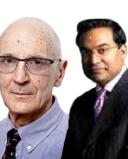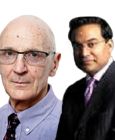Health
Why Do Patients Stop Dying When Doctors Go on Strike?
Can psychology explain our surprise at mortality decreases when doctors strike?
Posted October 17, 2015 Reviewed by Ekua Hagan

Doctors in the U.K. are considering whether to strike over proposed changes in their contracts, and they are marching in London as part of the protest. What's the likely impact of withdrawing medical care on the health of the nation? Physicians seem to be gambling that the government doesn't want to alarm the electorate.
But when doctors strike, the scientific research shows that patients stop dying.
The most comprehensive review of the medical impact of doctors' strikes is published in the prestigious academic journal Social Science and Medicine. A team lead by Solveig Cunningham and Salim Yusuf at Emory and Georgetown Universities in the U.S. and McMaster University in Canada, analysed five physician strikes around the world, all between 1976 and 2003.
Doctors withdrew their labour, in the different strikes analysed, from between 9 days and 17 weeks. Yet all the different studies report population mortality either stays the same, or even decreases, during medical strikes. Not a single study found death rates increased during the weeks of the strikes, compared to other times.
For example, in Los Angeles County, California in January 1976, doctors went on strike in protest over soaring medical malpractice insurance premiums. For five weeks, approximately 50% of doctors in the county reduced their practice and withheld care for anything but emergencies. One analysis, quoted by Cunningham and colleagues, found the strike may have actually prevented more deaths than it caused.
The study entitled, "Doctors' strikes and mortality: A review," suggests that it's the fact that elective, or non-emergency surgery, tends to stop during a doctors' strike, which seems to be the key factor. It looks like a surprising amount of mortality occurs following this kind of procedure which disappears when elective surgery ceases due to doctors withdrawing their labour. Mortality declined steadily from week one (21 deaths/100,000 population) to weeks six (13) and seven (14), when mortality rates were lower than the averages of the previous five years.
However, as soon as elective surgery resumed, there was a rise in deaths. There were 90 more deaths associated with surgery for the two weeks following the strike in 1976 (ie when doctors went back to work) than there had been during the same period in 1975.
But, unlike Los Angeles, what about the impact of doctors' industrial action where the majority of doctors participate, and the strike lasts several months?
Cunningham and colleagues report on a strike in Jerusalem from 2 March to 26 June 1983 due to a salary dispute between the government and the Israel Medical Association. 8000 of Jerusalem's 11,000 physicians refused to treat patients inside hospitals, though many of them set up separate aid stations where they treated emergency cases for a fee.
One analysis examined death certificates from several months surrounding the strike period, 16 February-3 September 1983, and from a control period the previous year, 17 February-3 September 1982. Mortality did not increase during or after the strike, even when elective surgery resumed.

The pre-strike deaths for the control period and the strike period were identical at 89; there were six fewer deaths during the strike than during the control period, while in the ten weeks following the strike, there were seven more deaths than there had been in 1982.
In an example of how a doctor's strike can backfire, the authors of this particular mortality analysis argued this apparent lack of impact of the strike on mortality suggests that there was an over-supply of doctors in Jerusalem at the time. The problem with drawing conclusions remains that the strike did not involve the whole scale deprivation of medical services.
Cunningham and colleagues point out in their review paper that striking physicians opened aid stations, supplementing medical care, and preventing people from mobbing the hospitals. While physicians were technically on strike during the four months of the dispute, most did not, in fact, adhere to the industrial action regulations. In truth, most doctors in Jerusalem provided care in a private or partially private context, so, while participating in spirit, they did not actually withdraw services.
Another intriguing study analysed changes in mortality by studying the Jerusalem Post's newspaper reports of funerals during another Jerusalem doctors' strike, this time between March and June of 2000. This one arose from the Israel Medical Association's conflict with the government's proposed wages. The hospitals in the area canceled all elective admissions and surgeries but kept emergency rooms and other vital departments, such as dialysis units and oncology departments, open.
The funeral study found a decline in the number of funerals during the three months of the strike, compared with the same months of the previous three years. One burial society reported 93 funerals during one month of the strike (May 2000) compared with 153 in May 1999, 133 in May of 1998, and 139 in May 1997.
Cunningham and colleagues summarise their review of research assessing the effects of doctors' strikes on mortality, finding that four of the seven studies report mortality dropped as a result of medical-industrial action, and three observed no significant change in mortality during the strike or in the period following.

There are several possible interpretations of this surprising finding. One is that as its elective or non-emergency surgery which is usually most effected in a doctor's strike, it could be the mortality findings reflect an impact of elective surgery. The findings might be important because they perhaps illuminate the relatively high risks of elective surgeries, which may actually increase mortality. If it wasn't for doctor's strikes, this might be a finding, ironically never otherwise properly highlighted.
Another sobering possible conclusion is that the public, and perhaps doctors themselves, overestimate the ability of medicine to stave off or have an impact on mortality.
However, Jonathan Gruber and Samuel Kleiner analysed the effects of nurses' strikes in hospitals on patient outcomes using nurses' strikes over the 1984 to 2004 period in New York State. The paper entitled, "Do Strikes Kill? Evidence from New York State," found nurses' strikes increase in-hospital mortality by 19.4% and 30-day readmission by 6.5% for patients admitted during a strike. The authors, from MIT and Carnegie Mellon University, conclude, in their paper published as National Bureau of Economic Research Working Paper No. 15855, that hospitals during nurses' strikes are providing a lower quality of patient care.
It would seem the public should worry much more about nurses going on strike compared to doctors, yet the irony is, nurses seem to earn a lot less than doctors.
The problem with interpreting the data, on doctors’ strikes, as Cunningham and colleagues point out in their review paper, in all medical strikes studied so far, not all doctors down tools. In the 1976 Los Angeles strike only 50% of physicians were involved. So doctors' strikes don't necessarily drastically reduce access to health care. Given the purpose of most strikes is to deprive management of the worker's labour, and it's benefits, this raises the sobering question of how effective a doctors' strike can ever be in comparison to other occupations.
The very difficulty in getting physicians to withdraw their labour in the way other occupations can do, hints at a fundamental difference between what it is to be a doctor, compared to pursuing other ways of making a living. A doctor, the research on strikes illuminates, isn't something you do, it's something you are. This issue of identity is why it's so much more difficult for doctors to simply discontinue practicing medicine. It's a character flaw prone to exploitation by governments and employers, effectively frustrating standard union tactics.
The Minister of Health in the U.K., Jeremy Hunt, is opposing the doctors and their threats of industrial action; in a recent comment widely reported, he explains why the state wants to change doctors’ contracts, apparently to provide more medical cover of hospitals at week-ends. He said: ‘…three times less medical cover at weekends as they (doctors) do in weeks and that means that there's a 15% greater chance of you dying if you are admitted on a Sunday, compared to being admitted on a Wednesday.’
There is indeed something paradoxical about the data showing that being admitted to hospital when there are fewer doctors at week-ends leads to greater mortality, compared to the research on doctors’ strikes.

Could it be that the way medicine and health care are organised, rather than simply having lots of doctors around, is the fundamental issue? The UK Government may have cleverly distracted attention away from the deep problems over how healthcare is managed in the UK, by highlighting instead the issue of forcing doctors to be present at week-ends.
Yet another irony is that the data from doctors strikes themselves indicate the issue isn’t as simple as just deploying more doctors means lives get saved.
But the outcome of the current conflict between doctors and their state employer in the U.K. may hinge on which side the electorate believes is genuinely most interested in looking after patients, as opposed to protecting their own interests.
If doctors don’t all go on complete strike, even when it could be in their financial interests to do so, this may signal to the public who to trust on this one – their doctors or their politicians.
Another theory as to why patients live longer when doctors go on strike is that the profession finally shakes off the shackles of its employer's restrictive practices, and returns, albeit temporarily, to practicing medicine freely, as it would really like to.
And perhaps, that's actually the most effective sort of industrial action doctors can ever take.
Raj Persaud and Peter Bruggen now have a free app on iTunes and Google Play entitled "Raj Persaud in Conversation," which includes a lot of free information on the latest research findings in mental health, plus interviews with top experts from around the world.




